 |
|

|
 |
TABLE of CONTENTS
 |
Winter keeps snowplow crews busy |
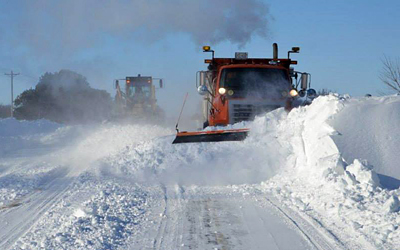
Crews plow Hwy 28 west of Sauk Centre. Photo courtesy of District 3. |
If you think the one-two punch of snow-and-ice has packed a wallop this winter, you wouldn’t be alone. Or wrong. Just ask MnDOT’s snowplow crews who have spent most days of the past two months keeping the state’s highways open and safe for motorists.
Consider, for example, this snapshot of January:
- District 3 had crews working 30 of 31 days on snow and ice operations.
- Metro District and District 4 crews treated or plowed roads 29 of 31 days.
- District 6’s East Operations had 35 split shifts (two 12-hour shifts) and West Operations had 26 split shifts.
- District 8 had split shifts for 22 out of 31 days. In the past four years, the district has averaged about 40 days of split shifts; already this winter it has 38 days. District 8 also reports its all-time high of vehicle-plow hits: six.
Note: Data from districts 1, 2 and 7 was not available at publication time.
While these numbers are just the (ahem) tip of the ice berg, you get the picture: Winter 2013-14 has kept MnDOT crews busy. No predictions yet when winter will ease its icy grip, but in 2013, Minnesota had snow in May.
Commissioner recognizes efforts of MnDOT’s “snowplow team”
Editor’s note: This is a reprint of a note Commissioner Charlie Zelle sent Jan. 28 to all employees, recognizing the efforts of MnDOT’s snowplow teams.
Hello,
The new year has rolled in with some very difficult and significant weather across the state. Snow storms, howling winds and extreme cold have made this a January to remember.
Through it all, the MnDOT maintenance folks, our snowplow operators and maintainers, have done outstanding work. They have toiled in difficult and sometimes dangerous circumstances to help keep the state’s roadways clear so travelers can get from point A to point B.
Their effort is indicative of every MnDOT employee. They are dedicated and committed professionals who give their best every day.
I want you to know how much I appreciate that and how proud I am to be part of this organization.
I know winter has a ways to go and likely we still have many miles of road to plow. Fortunately, for the citizens of Minnesota, our incredible snowplow operators will be there to clear the roads.
Thanks,
Charlie Zelle
Commissioner, MnDOT |
|
 |
|

|
 |
TABLE of CONTENTS
 |
Transportation Conference coming in March |
|
Minnesota's Transportation Conference will be held March 4-6 at the Double Tree Hotel in Bloomington. The conference will highlight the latest innovations in transportation, offer face-to-face interaction with transportation partners and leaders, cover funding and finance education, provide creative ideas and tools to take back to the office, and show how transportation advances are supporting Minnesota's economic development and improving quality of life.
For full program information, download the preliminary conference program or the preliminary program-at-a-glance.
“Getting the Minnesota transportation community “under one roof” has been the cornerstone of this Conference,” said Sue Mulvihill, deputy commissioner/chief engineer. “MnDOT employees will have the opportunity to learn, collaborate, reinvigorate and share the wonderful things they do. This opportunity has not happened for over 10 years.”
Conference registration process for MnDOT
MnDOT attendees should follow the four-step registration procedure listed below. MnDOT registrations must be processed through one’s designated training and development specialist. MnDOT registrations submitted directly to the U of M will be returned to the sender. The registration deadline for MnDOT staff is Monday, Feb. 10.
- Obtain supervisory approval before registration.
- Complete Minnesota’s Transportation Conference registration form at http://mntransportationconference.org/registration/documents/MTCregistrationform.pdf
- Follow your district/office procedure for submission of training registrations.
- Local area training and development specialists will forward registration information to the Conference Registration staff. Enrollment confirmation will be sent via email.
Questions regarding registration or the conference may be directed to your training coordinator or Brad Hamilton at brad.hamilton@state.us. |
 |
|

|
 |
TABLE of CONTENTS
 |
Correctly navigating a multi-lane roundabout |
This video shows drivers how to navigate a multi-lane roundabout and what to do when large vehicles and emergency vehicles are traveling through the roundabout. Video produced by the Minnesota Local Road Research Board |
|
 |
|

|
 |
TABLE of CONTENTS
 |
Daniel DuHamel appointed as special assistant to the deputy commissioner |
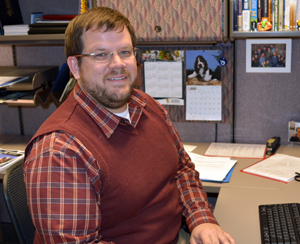
Daniel DuHamel started as the special assistant to the deputy commissioner Jan. 29. Photo by Rich Kemp |
Daniel DuHamel has taken the newly created position of special assistant to the deputy commissioner, effective Jan. 29. DuHamel comes to MnDOT from the Minnesota Department of Human Services.
He brings with him extensive executive management and government experience. He was a community action program administrator at DHS, an officer at a local non-profit organization, and an adjunct faculty member with Globe University and Cardinal Stritch University. DuHamel holds a master’s degree in public policy from the Humphrey Institute of Public Affairs and a master’s in education/HR development from the University of Minnesota.
“He is a very detail-oriented leader, but also has a great strategic mind,” said Tracy Hatch, deputy commissioner, chief operating officer and chief financial officer. “He will be a great addition to the MnDOT team.”
DuHamel's office is on the 4th floor of the Central Office. His phone number is 651-431-3819. |
 |
|

|
 |
TABLE of CONTENTS
 |
Employee resource groups foster understanding, sense of community |
|
By Sue Roe MnDOT’s employee resource groups play a major role in building a more diverse and inclusive workplace. The ERGs were sanctioned last year by MnDOT as a way to connect employees of traditionally under-represented people and their allies and to help support the agency’s strategic vision.
MnDOT’s five ERGs are the African American; Indigenous; Q&A or Queers and Allies; Fully Utilizing Employees without Labeling or FUEL; and Strategic Women Advancing Transportation or SWAT.
“ERGs have a mutually beneficial relationship with MnDOT,” said Rosemarie Merrigan, diversity and inclusion manager. “They are organized in a way for employees to be able to support each other and the agency by doing incredible work.”
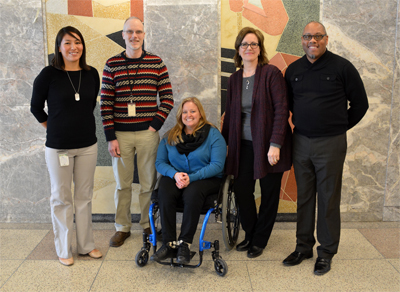
Members of the Employee Resource Groups leadership team are, from left, Inyan Walking Elk, Bruce Tanquist, Heidi Bryand, Deb Ledvina and Keith Baker. They represent the five ERGs in MnDOT. Rosemarie Merrigan, diversity and inclusion manager, is the leadership team leader. Photo by Rich Kemp |
That work includes professional development, recruitment, retention and community outreach. Each ERG has a work plan that includes its purpose and goals that align with one or more of the four focus areas. The groups sponsor various activities to foster understanding, bring a sense of community to the workplace and help MnDOT be seen as a place that represents the communities it serves.
The African American ERG was informally structured before becoming formally organized in 2013. The group, chaired by Keith Baker, transportation program supervisor, has the goals of promoting cultural competence, communicating career opportunities within and outside MnDOT, assisting in the advancement of African American employees throughout MnDOT and identifying areas of opportunity to create an inclusive and productive business environment.
Baker said the group builds credibility within African American communities with such activities as participating in the Rondo community’s annual parade.
“This is a way of reducing isolation by connecting to the neighborhoods we serve. We’d like to help MnDOT recruit and retain a diverse workforce,” said Baker.
The ERG has hosted an African Americans in Transportation series at the Minnesota History Center for the past four years. Future activities include brown bag events and partnering with the Aeronautics division and other aviation groups to bring a Tuskegee Airmen exhibit to the State Capitol.
SWAT brings attention to the contributions of women managers in non-engineering disciplines and explores ways to maximize their potential to further the agency’s vision. Deb Ledvina, chairwoman and transportation ombudsman, said the group organized last summer and one of the meetings was a book discussion about women in the workplace.
The Indigenous ERG’s work plan includes all four focus areas, said Inyan Walking Elk, chairwoman and work zone safety awareness program coordinator.
“We try to teach our culture and history, not in a way to separate, but to bring more understanding,” Walking Elk said. “We want to create a peaceful workplace not so much because we should get along, but so we do so through understanding one another.”
There are 11 indigenous tribes in Minnesota, but only one percent of MnDOT’s workforce is indigenous.
“As far as recruiting, we have our work cut out for us, but that’s the change we’d like to effect,” she said.
The group hosted a “Why Treaties Matter” exhibit and open house, and participated in a parade during American Indian Month. The group also hosted a speaker and screening of the documentary Dakota 38 and presented a breakout session during the National Tribes and Transportation Conference last fall. A storytelling event will be held in the Central Office in March, and the group collaborated with the African American ERG during a Black History Month event.
The Q&A ERG’s goal is to provide a safe and respectful workplace for lesbian, gay, bisexual, transgender, questioning or queer employees and to promote MnDOT’s commitment to diversity and inclusion and as a workplace of choice, according to Bruce Tanquist, chairman and senior engineer.
“We also want to provide education about the LGBT community,” Tanquist said. The group intends to provide training to its allies to help people be supportive of LGBTQ co-workers.
The ERG sponsored a MnDOT truck in the Gay Pride parade, held brown bag events and displayed posters at Central Office of famous LGBT people.
The fifth ERG group, FUEL, also was informally organized prior to the formation of ERGs. It works to build awareness and foster dialogue about disability issues faced by state employees; educate people on the skills and abilities as well as obstacles faced by people with disabilities; and empower MnDOT employees to engage in community outreach related to transportation and mobility for people with differing abilities.
“There are opportunities for FUEL to focus on recruitment,” said Ken Rodgers, who co-chairs the group with Heidi Bryand, and serves as the disabilities program coordinator in the Affirmative Action office. He cited federal and state initiatives to increase the hiring of people with disabilities, which is an under-represented group at MnDOT.
The ERG will sponsor an event March 13 about guide dogs and service animals.
Membership in any of the groups is open to anyone who supports the groups’ mission and goals. Anyone who wants to be a member or ally can contact the group’s leader or go to the ERG web page. Anyone interesting in forming a new ERG may also go to the website or contact Merrigan at rosemarie.merrigan@state.mn.us.
African Americans and the Great Waterways featured during Black History Month
The African American Employee Resource Group will honor African Americans in transportation during Black History Month Feb. 13 from 11:30 a.m. to 1 p.m. at the Minnesota History Center. “African Americans and the Great Waterways” will feature the contributions of early African American voyagers, explorers and pioneers to the movement of goods and the role they played in building relationships among different groups around the Great Lakes and Northern Territories. The event is free and open to the public.
“We try to create events related to transportation and give people a chance to explore the unknown stories of the contributions of African Americans,” said Keith Baker, chairman of the African American ERG. “We’re constantly learning new things about our workforce and the communities we serve. It’s important to acknowledge and reflect those things of interest to those communities.”
During the event, a panel will discuss early African American settlements in Minnesota and Wisconsin, fur and lumber trading posts and ports, post-civil war relationships between African Americans and Indians, and early transportation. |
|
 |
|

|
 |
TABLE of CONTENTS
 |
Ombudsman’s Office serves public, MnDOT |
By Julie Tietz, Office of Ombudsman
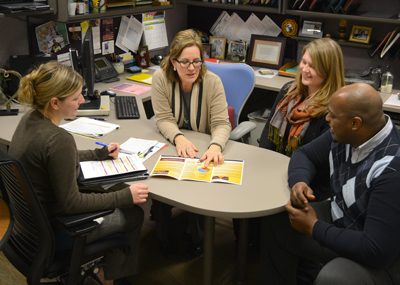
Deb Ledvina, transportation ombudsman, talks with some of her staff about their annual report. From left: Christine Thomas, Ledvina, Julie Tietz and Marcell Walker. Photo by Rich Kemp |
After five years in existence, the Ombudsman’s Office continues to grow and refine its services to best serve the citizens of Minnesota and MnDOT. The ombudsman is a neutral, informal and independent resource that helps the public and MnDOT resolve transportation related issues. During the past five years, the office handled a total of 303 cases requiring resolution, including 73 new cases requiring resolution in 2013.
“We refined our case protocol, changed the format of our annual and district case reports, increased our site visits, and provided more guidance to the districts on potential issues than in previous years,” said Deb Ledvina, transportation ombudsman.
The office worked this year to concentrate on issues that are truly conflicts, Ledvina said. The ombudsman staff collaborated with Customer Relations, Office of Chief Counsel and districts to refine protocols so appropriate referrals are made to constituents to assist them in resolving their issue.
In general, an issue is handled by the Ombudsman’s Office when a constituent has first tried to resolve it through normal processes and procedures through a district.
“There are some additional instances when our office will become involved in an issue,” said Ledvina. “These include unsatisfied constituents who have worked with a district, the relationship with a district is not collaborative or a legislator has contacted our office to look into an issue.”
The office works with constituents to help them better understand why a decision was made or to further clarify a process or procedure.
The Ombudsman’s Office not only serves the public, but also MnDOT. The Ombudsman’s Office staff is available to districts and specialty offices for advice and guidance on difficult issues they are handling. The office also facilitates discussions to aid the department on issues they are working on with the public. Facilitated discussions provide an opportunity for parties to come together and resolve the issue with a neutral party present.
“I want to thank everyone at MnDOT for working collaboratively to find resolution to matters that come to our office,” said Ledvina. “I look forward to continuing these collaborative relationships in the future.”
For more information, contact Ledvina at 651-366-3052.
|
 |
|

|
 |
TABLE of CONTENTS
 |
MnDOT seeks research implementation proposals |
By Shannon Fiecke, Research Services & Library

MnDOT is implementing research designed to count bicycle and pedestrian traffic. Photo by David Gonzalez |
MnDOT is seeking pilot projects to put new transportation research into practice. You can submit your research implementation ideas until Feb. 14 using the Minnesota Transportation Research Collaboration Website.
Research implementation projects take research results and put them to work. For example, later this year MnDOT is scheduled to finish installing several types of bicycle and pedestrian traffic counting equipment in locations around the state. The project is implementing results of a study that developed guidance and protocols for counting non-motorized traffic.
Once your ideas are submitted, MnDOT Research Services & Library staff will work with you to develop an implementation plan and project proposal. Visit the research collaboration website for more information on how to submit your idea. |
 |
|

|
 |
TABLE of CONTENTS
 |
On the Job: Justina Norring troubleshoots to help employees |
By Lisa Yang
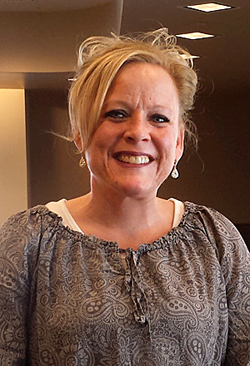
Justina Norring, IT Service Desk, enjoys helping people with a variety of tasks and major projects such as computer troubleshooting and the deployment of Windows 7. Photo by Lisa Yang |
When employees are faced with computer-related issues, their first point of contact is usually the IT Service Desk. Some may have received help from Justina Norring, IT Service Desk and information technology specialist.
Norring works in Central Office and has been part of the IT Service Desk for three and a half years. Before that, she worked in the Office of Human Resources and later changed her career path to the IT field while working for the Department of Corrections. She’s worked for the state for 17 years.
Since the IT consolidation last year, the IT Service Desk serves 5,000 MnDOT employees statewide.
What’s changed for the IT Service Desk since the IT consolidation?
Now that we’re all consolidated, someone from the service desk may help you remotely from a different location but we make sure someone can still help you in person if needed.
Our customer base is on a larger scale now and there’s a wider range of people we are helping. Our group is learning together and trying to be consistent with employees across the board.
What are the challenges and positives of your job?
A challenge is prioritizing when everything is priority. Also, the ability to switch gears at any time is important. We try to accommodate employees and have a resolution in a timely fashion. Since we’re serving a wider range of people, this brings on other challenges, such as being familiar with more software and changes.
Our group works well together as a team and I think that’s what makes things run so smoothly. There are things we just don’t have control over but we do the best we can.
Everything is a team approach because 10 brains and 10 sets of eyes are better than one. Depending on what we’re faced with, sometimes it’s easy to separate and come back together for a resolution. We all pitch in and help each other, which is fantastic. There are positive outcomes once it’s all said and done and the user is happy and taken care of.
What can the IT Service Desk help with and how many requests do you usually receive?
There’s a wide and vast variety. We handle everything from hardware and software problems, phone issues, computer rebuilds and imaging, troubleshooting computer errors, unlocking user accounts, syncing up users’ iPads, loaning out laptops, setting up new workstations and printer connections, setting up users’ email profiles, training employees how to use something…there are things that are very complex and there are other things that are simple and cut and dry.
On average, we receive roughly 80 phone calls a day and 135 requests through walk-ins, emails, by the remedy self-service console, and directly. We get requests statewide from all offices, truck stations and districts.
What is the process that requests go through?
All requests are completed through our remedy database. As requests come in, they are assigned to a technician and then prioritized based on how many people it affects. If it affects the entire department, it would be addressed first.
Employees can submit requests through the remedy self-service console, which is a web-based application and database. There’s an icon for it on your desktop that you can click on to open the application. This isn’t available to Central Office employees but they’ll be on board in the near future.
Employees can also email *DOT_ITServiceDesk or itservicedesk.dot@state.mn.us to submit a request or call our main line number at 651-355-0200.
What’s current or new for the IT Service Desk?
There are major projects going on in IT that the service desk is assisting with, such as deploying Windows 7. That was a huge feat for us. We are also trying to get everybody on board with Lync, Bridgit and smart boards. Last year was a big year for us because we were able to bring all of those things in.
What do you enjoy most about your job?
I really do enjoy the people side of things and working with people. It is a position where you fix things, so once you fix it, people are happy.
It’s challenging, motivating and fun. Things are always evolving in the IT field and you’re constantly learning something new and constantly being challenged. |
 |
|

|
 |
TABLE of CONTENTS
 |
Mike McNeally retires after 52 years of service |
By Rich Kemp
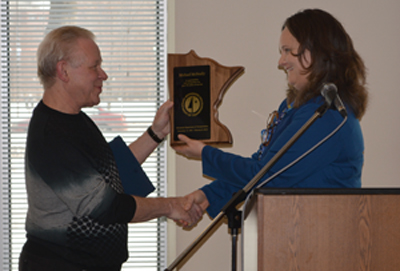
Mike McNeally receives an award from Robin Sylvester, Office of Administration director, during his retirement ceremony Feb. 5 at the Central Office. McNeally is retiring after 52 years of state service. Photo by Rich Kemp |
What would it be like to work five decades for MnDOT? You can ask Mike McNeally that question. He retires this month after 52 years of state service.
McNeally started in 1961 in Motor Vehicles, mailing out license plates to vehicle owners. After two months, he said he got a real job with the State Highway Department.
“The biggest change has been in technology,” said McNeally. “We didn’t have computers when I started, we used manual typewriters. Just look at where we are today.”
McNeally started in Road Design, delivering mail and helping with timesheets. It was the beginning of his time working with timesheets. He went on to work in Program Management, Finance, Desktop Support and finally Administration.
“My fondest memories are from traveling around the state,” said McNeally. “We would go out to the districts and provide training.”
He and Jackie Smiley drove to the districts to conduct VoIP phone system training. “I baked cookies for every training session,” said McNeally. He also conducted RCA timesheet training, along with Barb Raven at the Training Center. They also traveled to the districts to provide the training.
“Mike has truly been a dedicated state employee,” said Sue Heurung, division business manager. “He has gone the extra mile and taken extreme pride in helping other employees understand how to accomplish many business processes.”
The other big change McNeally went through was the change from the Highway Department to the Department of Transportation in 1976.
“I would like to thank all the employees who have touched my life for 52 years,” said McNeally. “It has been a pleasure working here. Who knew it would last that many years in one building.”
When asked what he will do in retirement, he said he will continue to play the keyboards at St. Odilia Church and do volunteer work. |
 |
|

|
 |
TABLE of CONTENTS
 |
Donated vacation hours sought for Metro's Kevin Walker |

Kevin Walker, public affairs coordinator, is in need of donated leave after several medical procedures. Photo by David Gonzalez |
If you work at the Waters Edge Building in the Metro District, you may have noticed the absence of a smiling face around the office.
Kevin Walker, a 29-year veteran of MnDOT, a public affairs coordinator, has been out on medical leave dealing with a serious medical condition requiring several surgeries.
As a result of the extensive medical procedures Walker has undergone, he has exhausted all his vacation and sick leave. He has been approved for the State Employee Vacation Donation program, which allows employees to donate up to 40 hours vacation per fiscal year to approved recipients.
Since 2010, Walker has endured numerous surgeries to replace a deteriorated hip, but has encountered several setbacks including faulty hip hardware and, most recently, a serious blood infection. Once the infection is gone, Walker faces another hip surgery, requiring additional rehabilitation and recovery time.
"Many of us really miss his smile and look forward to seeing him walk the halls at Metro once again, so any contribution you can make to help him through this difficult physical and emotional time would be greatly appreciated," said Denise Workcuff, Metro District public affairs coordinator.
To donate vacation leave:
- Go to Employee Self Service Website, click on “Other Payroll,” then “Leave Donations.”
- Select the magnifying glass next to “Reserve Bank” and choose “Walker”
- Enter the number of hours you wish to donate
- Click on the yellow “Save” box
Donation forms are also available from your Payroll or Human Resources office or at www.mmb.state.mn.us/doc/vacation/pe665.pdf. |
 |
|

|
 |
TABLE of CONTENTS
 |
MnROAD earns Concrete Pavement Association award |
By Rich Kemp
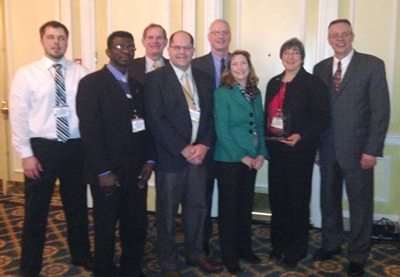
(far right) Gerald Voigt, ACPA president and CEO, presented MnDOT with the Marlin J. Knutson Award for Technical Achievement during a ceremony in December. Receiving the award are (from left) Luke Johanneck, Bernard Izevbekhai, Roger Olson, Tom Burnham, Glenn Engstrom, Maureen Jensen and Sue Mulvihill. Photo courtesy of the ACPA |
Staff from MnROAD, the agency’s cold weather road research facility in Albertville, were presented with the Marlin J. Knutson Award for Technical Achievement by the American Concrete Pavement Association in December. The award was presented during the ACPA’s Distinguished Service and Recognition Awards ceremony.
The award cites the facility’s well-deserved reputation for being a place where both agency and industry ideas are put to the test. This award was presented as a tribute to the agency’s commitment to learning and putting ideas into practice.
The Marlin J. Knutson Award for Technical Achievement is presented to an individual or group who has made significant contributions to advance the development and implementation of technical innovations and best practices in the design and construction of concrete pavements.
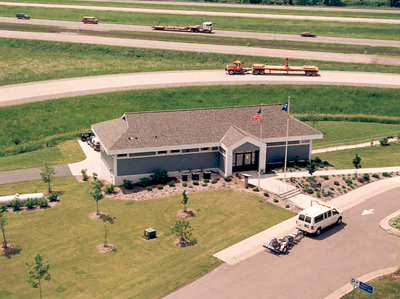
Staff from the MnROAD facility in Albertville were recognized by the ACPA during a ceremony in December. Photo by David Gonzalez |
“MnROAD is helping to make roads last longer, perform better, cost less, construct faster, and have minimal impact on the environment,” said Gerald Voigt, ACPA president and CEO. “It is a model for other agencies to follow.”
MnROAD is a pavement test track initially constructed between 1991-1993. It uses various research materials and pavements and finds ways to make roads last longer, perform better, cost less to build and maintain, be built faster and have minimal impact on the environment. MnROAD consists of two unique road segments located next to Interstate 94.
|
 |
|
| |
|



